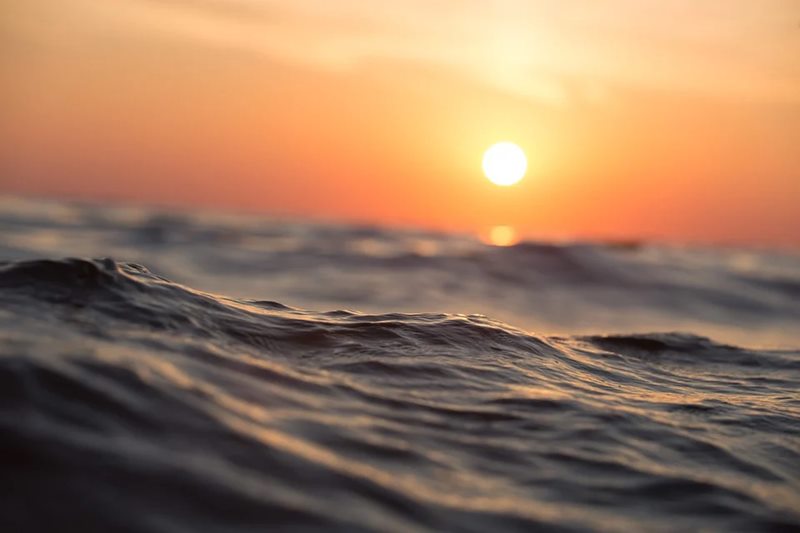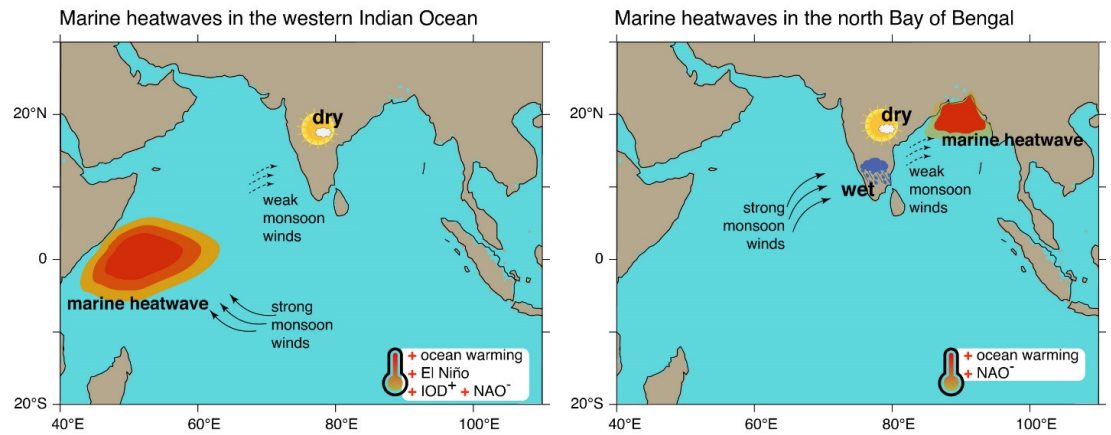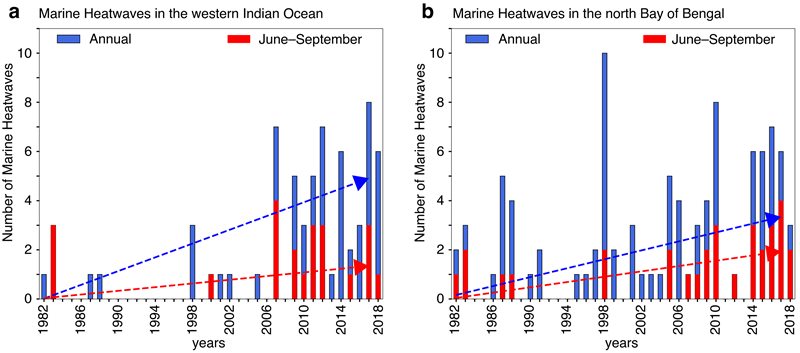Reduced rainfall over central India, rising precipitation in south India – scientists blame marine heatwaves
Marine heatwaves in the western Indian Ocean and the Bay of Bengal are resulting in drying conditions over the central Indian subcontinent. But, there is a significant increase in the rainfall over south peninsular India due to the heatwaves in the north Bay of Bengal, finds an IITM study.


Increasing marine heatwaves are aided by rapid warming in the Indian Ocean and strong El Niños. Photo: Pixabay
Do you know that apart from land even the oceans have heatwaves? Known as marine heatwave, it is a period of extremely high temperature in the ocean. And these marine heatwaves are on the rise in the Indian Ocean and are having an impact on the Indian monsoon rainfall. On the one hand, rainfall over the central Indian subcontinent is reducing, whereas it is increasing over the southern peninsula.
These are some of the key findings of a recent study – Genesis and Trends in Marine Heatwaves Over the Tropical Indian Ocean and Their Interaction With the Indian Summer Monsoon – conducted by Pune-based Indian Institute of Tropical Meteorology (IITM).
Researchers of the study point out that increasing marine heatwaves are aided by rapid warming in the Indian Ocean and strong El Niños. El Niño is the warming of the ocean surface, or above-average sea surface temperatures (SST), in the central and eastern tropical Pacific Ocean. El Niño has been linked to extremely hot years and droughts.

“Climate model projections suggest further warming of the Indian Ocean in the future, which will very likely intensify the marine heatwaves and their impact on the monsoon rainfall,” Roxy Mathew Koll, who led the study, was quoted in the press statement dated February 1.
“Since the frequency, intensity, and area covered by the marine heatwaves are increasing, we need to enhance our ocean observational arrays to monitor these events accurately, and update our weather models to skillfully predict the challenges presented by a warming world,” he added.
According to the study published in the journal JGR Oceans, these increasing marine heatwaves are reducing the rainfall over the central Indian subcontinent while enhancing it over the southern peninsula.
Heatwaves in the Indian Ocean
The marine heatwaves in the western Indian Ocean and the Bay of Bengal are found to result in drying conditions over the central Indian subcontinent. At the same time, there is a significant increase in the rainfall over south peninsular India in response to the heatwaves in the north Bay of Bengal.
The western Indian Ocean region experienced the largest increase in marine heatwaves at a rate of about 1.5 events per decade. It was followed by the north Bay of Bengal at a rate of 0.5 events per decade. During 1982–2018, the western Indian Ocean had a total of 66 events while the Bay of Bengal had 94 events.

Also Read: 80% Indians live in climate-vulnerable districts: Study
Of the 66 events over the western Indian Ocean, 21 were between June and September (monsoon months) while 34 of the 94 marine heatwaves events over Bay of Bengal.
“These heatwaves used to be rare in the tropical Indian Ocean, but now they have become an annual affair,” stated the IITM researchers in the press statement.
Also Read: Explained: How air pollution affects monsoon rains in India
Marine heatwaves cause habitat destruction due to coral bleaching, seagrass destruction, and loss of kelp forests, affecting the fisheries sector adversely.
An underwater survey showed that 85 per cent of the corals in the Gulf of Mannar near the Tamil Nadu coast got bleached after the marine heatwave in May 2020.

Also Read: How ‘uncontrolled, unplanned’ irrigation in northern India affects monsoon rainfall?

